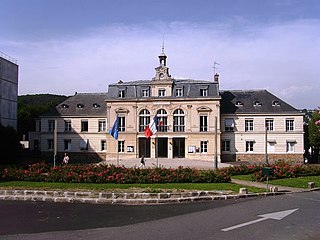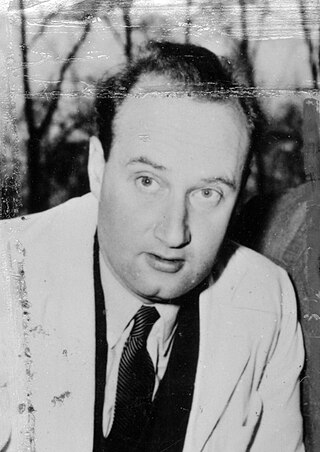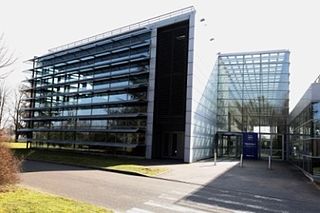
The French Alternative Energies and Atomic Energy Commission, or CEA, is a French public government-funded research organisation in the areas of energy, defense and security, information technologies and health technologies. The CEA maintains a cross-disciplinary culture of engineers and researchers, building on the synergies between fundamental and technological research.

Jean Frédéric Joliot-Curie was a French physicist and husband of Irène Joliot-Curie, with whom he was jointly awarded the Nobel Prize in Chemistry in 1935 for their discovery of induced radioactivity. They were the second ever married couple, after his wife's parents, to win the Nobel Prize, adding to the Curie family legacy of five Nobel Prizes. Joliot-Curie and his wife also founded the Orsay Faculty of Sciences, part of the Paris-Saclay University.

Orsay is a commune in the Essonne department in Île-de-France in northern France. It is located in the southwestern suburbs of Paris, France, 20.7 km (12.9 mi) from the centre of Paris.

Saclay is a commune in the southwestern suburbs of Paris, France. It is located 18.7 km (11.6 mi) from the centre of Paris. It is best known for the large scientific facility CEA Saclay, mostly dealing with nuclear and particle physics.
The French Institut de radioprotection et de sûreté nucléaire (IRSN) located in Fontenay-aux-Roses is a public official establishment with an industrial and commercial aspect (EPIC) created by the AFSSE Act and by February 22, 2002 decreed n°2002-254. The IRSN is placed under the conjoint authority of the Defence minister, the Environmental minister, the Industry minister and the Health and Research minister.

The Fort de Châtillon was a fortification located about 5 kilometres (3.1 mi) south of Paris in the communes of Châtillon-sous-Bagneux and Fontenay-aux-Roses. It was built in 1874 and was razed beginning in 1957, making way for expansion of the French nuclear research facility at Fontenay-aux-Roses.
The Zoé reactor, or EL-1, was the first French atomic reactor. It was built in 1947 at the Fort de Châtillon in Fontenay-aux-Roses, a suburb of Paris.

Paris-Sud University, also known as the University of Paris — XI, was a French research university distributed among several campuses in the southern suburbs of Paris, including Orsay, Cachan, Châtenay-Malabry, Sceaux, and Kremlin-Bicêtre campuses. In 2020, the university was replaced by the Paris-Saclay University.

Bertrand Goldschmidt was a French chemist. He is considered one of the fathers of the French atomic bomb, which was tested for the first time in 1960 in the nuclear test Gerboise Bleue.

Paris-Saclay is a research-intensive and business cluster currently under construction in the south of Paris, France. It encompasses research facilities, two French major universities with higher education institutions and also research centers of private companies. In 2013, the Technology Review put Paris-Saclay in the top 8 world research clusters. In 2014, it comprised almost 15% of French scientific research capacity.

Jules Guéron was a French physical chemist and atomic scientist who played a key role in the development of atomic energy in France.

Paris-Saclay University is a combined technological research institute and public research university in Paris, France. Paris-Saclay was established in 2019 after the merger of four technical grandes écoles, as well as several technological institutes, engineering schools, and research facilities; giving it fifteen constituent colleges with over 48,000 students combined.

Anne Geneviève L'Huillier is a French physicist, and professor of atomic physics at Lund University in Sweden.
Robert Dautray was a French engineer, scientific director of the French Commissariat à l'Energie Atomique (CEA) and High Commissioner for Atomic Energy. He was a member of the French Academy of Sciences, section mechanical and computer sciences, and of the French Academy of Technology.

The Paris-Saclay Faculty of Sciences or Orsay Faculty of Sciences, in French : Faculté des sciences d'Orsay, is the mathematics and physics school within Paris-Saclay University, founded in 1956. It offers undergraduate and graduate degrees in mathematics, physics and chemistry.

The Polytechnic Institute of Paris is a public technological university located in Palaiseau, France. It consists of five engineering grandes écoles: École polytechnique, ENSTA Paris, ENSAE Paris, Télécom Paris and Télécom SudParis.

Nathalie Palanque-Delabrouille,, is a French cosmologist. During her career as a researcher in particle physics, she has taken part in several large-scale experiments. Her work has been recognized several times including the Irène Joliot-Curie Prize, the appointment as Knight of the Legion of Honor and her election to the French Academy of Sciences.

Gilles Bloch is a French polytechnicien, doctor of medicine and researcher in molecular biophysics, specializing in muscle and brain metabolism. He was director general of research and innovation from 2006 to 2009, then president of Paris-Saclay University between 2015 and 2018, and president of Inserm between 2019 and 2023. Since September 2023, he has served as President of the National Museum of Natural History, France.

The history of France's military nuclear program recounts the path that led France to develop a military nuclear program after World War II. The establishment of the French Nuclear Dissuasion Force was based on a French nuclear testing program that began on February 13, 1960, and ended on January 27, 1996.

NeuroSpin is a high-field nuclear magnetic resonance (MRI) brain neuroimaging center and a department of the Frédéric Joliot Institute of Life Sciences of the CEA Paris-Saclay Research Center. It is a large research infrastructure aimed at pushing the current limits of brain imaging. It integrates the Biomedical Imaging Institute alongside two other research centers: the Frédéric Joliot Hospital Service of the CEA in Orsay and MIRCen in Fontenay-aux-Roses.


















